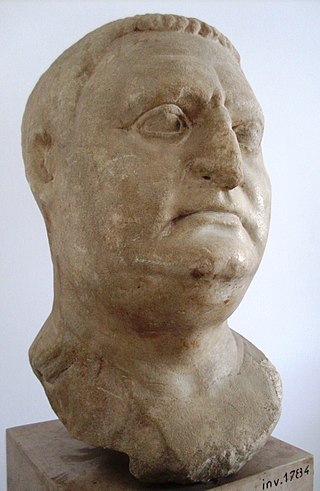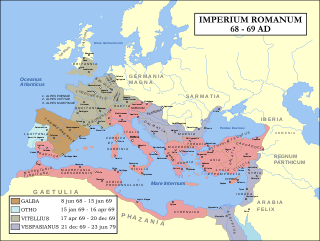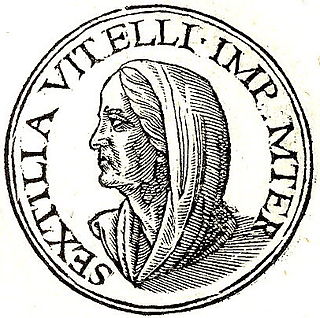
Otho was Roman emperor, ruling for three months from 15 January to 16 April 69. He was the second emperor of the Year of the Four Emperors.

Aulus Vitellius was Roman emperor for eight months, from 19 April to 20 December AD 69. Vitellius became emperor following the quick succession of the previous emperors Galba and Otho, in a year of civil war known as the Year of the Four Emperors. Vitellius added the honorific Germanicus to his name instead of Caesar upon his accession. Like his predecessor, Otho, Vitellius attempted to rally public support to his cause by honoring and imitating Nero who remained popular in the empire.

AD 69 (LXIX) was a common year starting on Sunday of the Julian calendar. In the Roman Empire, it was known as the Year of the consulship of Galba and Vinius. The denomination AD 69 for this year has been used since the early medieval period, when the Anno Domini calendar era became the prevalent method in Europe for naming years.

The Year of the Four Emperors, AD 69, was the first civil war of the Roman Empire, during which four emperors ruled in succession: Galba, Otho, Vitellius, and Vespasian. It is considered an important interval, marking the transition from the Julio-Claudians, the first imperial dynasty, to the Flavian dynasty. The period witnessed several rebellions and claimants, with shifting allegiances and widespread turmoil in Rome and the provinces.

La clemenza di Tito, K. 621, is an opera seria in two acts composed by Wolfgang Amadeus Mozart to an Italian libretto by Caterino Mazzolà, after Pietro Metastasio. Mozart began the work while he was finishing Die Zauberflöte, the last of his principal operas. La clemenza di Tito premiered on 6 September 1791 at the Estates Theatre in Prague.
Aulus Caecina Alienus was a Roman general active during the Year of the Four Emperors.
Junia Calvina was a Roman noblewoman who lived in the 1st century AD.
Marcus Annius Verus was the paternal grandfather and adoptive father of the Roman Emperor Marcus Aurelius, and father-in-law of emperor Antoninus Pius.
Lucius Vitellius was a Roman senator who lived in the 1st century. He was the second son of Lucius Vitellius and Sextilia, and younger brother of emperor Aulus Vitellius. Lucius was suffect consul in the nundinium of July-December 48 with Gaius Vipstanus Messalla Gallus as his colleague.
Publius Vitellius, grandfather of the emperor Vitellius, was a Roman eques, who served as procurator during the reign of Augustus.
Titus Flavius T. f. T. n. Sabinus was a Roman politician and soldier. A native of Reate, he was the elder son of Titus Flavius Sabinus and Vespasia Polla, and brother of the Emperor Vespasian.

Sextilia was the mother of Lucius Vitellius the Younger and Aulus Vitellius.

Galeria Fundana was a Roman empress and the second wife of Roman emperor Vitellius.
The gens Vitellia was a family of ancient Rome, which rose from obscurity in imperial times, and briefly held the Empire itself in AD 69. The first of this gens to obtain the consulship was Aulus Vitellius, uncle of the emperor Vitellius, in AD 32.
Libo Rupilius Frugi was a Roman senator and an ancestor of the emperor Marcus Aurelius. He served as suffect consul in 88.
Sulpicia Praetextata was an ancient Roman noblewoman who lived in the Roman Empire in the 1st century.
Decimus Valerius Asiaticus was a Roman Senator who served as a Legatus of Gallia Belgica.
Marcus Lollius Paullinus Decimus Valerius Asiaticus Saturninus was a prominent Roman Senator who was a powerful figure in the second half of the 1st century and first half of the 2nd century. He is also known by the shorter form of his name, Decimus Valerius Asiaticus.
Decimus Valerius Taurus Catullus Messallinus Asiaticus was a member of the Arval Brethren who lived in the second half of 1st century and first half of 2nd century.
The gens Galeria was a Roman family of Imperial times. The family first rose to prominence under the Julio-Claudian dynasty, but the most illustrious person of the name was the emperor Galerius, one of the heirs of Diocletian, who reigned from AD 305 to 311, although he cannot have been a direct descendant of the earlier family.








